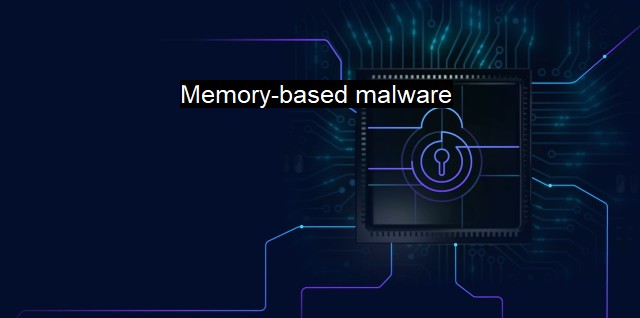What is Memory-based malware?
The Looming Threat of Memory-Based Malware and How It Impacts Computer Systems: An Overview of Detection and Prevention Techniques.
Memory-based malware, also known as fileless malware or non-malware, is a type of malicious software that primarily resides in a computer's RAM, rather than on the hard drive, as traditional malware does. memory-based malware stands as an escalating threat owing to its existing sophistication and increasingly extensive use. Its unique characteristic is that it doesn't rely on files and leaves no traditional footprint, making it particularly hard for traditional antivirus software to detect and eliminate it.The fundamental difference between memory-based malware and traditional malware lies in their method of operation. Traditional malware involves downloading and executing a program that infiltrates the system by altering discoursed files or system configurations. In contrast, memory-based malware infects a system directly in stream, requiring no direct file alteration or installation. Instead, it resides transiently in memory (RAM) and can manipulate or exploit various legitimate applications and services on the main hosting device to perform its malicious activities.
This type of malware operates using straightforward yet elegant mechanics. It often deploys scripts or malicious codes via command prompts, PowerShell or Windows Management Instrumentation, which then ends up within the memory. Importantly, it is then executed and eradicated all while in random access memory (RAM), without touching the disk. The only reservatory interaction between this type of malware and the underlying system occurs via legitimate processes or services.
Memory-based malware represents a significant threat as it effectively bypasses traditional antivirus-defence mechanisms. Antivirus software usually scans the hard drive for suspicious changes or suspicious software signatures, but memory-based malware avoids the storage area altogether. That deception makes detection and remediation a challenge, particularly for software centered on hard drive scanning techniques.
The stealthy nature of memory-based malware empowers infected systems to continue its typical routine operations without raising any immediate suspicious activities. this malware can cease without a trace once the system restarts, given its residence solely in volatile memory. some advanced strains employ persistence techniques to re-infect after each restart.
Adding to the challenge, fileless malware uses whitelisting tools or existing trusted programs for its operations, manipulating them to perform harmful activities. This manipulation makes it even harder for detection tools to exemplify them as threats, primarily if the security tools center around blacklist approaches.
Common examples of memory-based attacks include spear-phishing emails or harmful web content that instigate the user to execute PowerShell or JavaScript code. For instance, the attack exploits like PowerSploit and Angler have maliciously utilized PowerShell, JavaScript, or VBScript into loading harmful scripts directly into memory.
Countermeasures against memory-based malware comprise advanced threat detection solutions that focus on behavior rather than signatures. Detection systems require constant updates to handle the ever-evolving threats and the potential for new, undiscovered methods of bypassing traditional defenses. Behavior-based monitoring, focusing on the system interactions and memory behaviors above the mere scanning of file signatures, serves to undermine the unnoticed operation of memory-based malware.
Companies can limit the use of interactive PowerShell to those requiring its features for standard operational needs, whitelist application control, or implement patches across their environment.
Memory-based malware represents a growing and evolving threat within today's cybersecurity landscape. The sophistication of this malware and its capability to circumvent conventional security measures underscores the need for continuous innovation within the cybersecurity field. As it stands, this dynamic environment calls for improved, proactive defenses centred on behavior-based detection, comprehensive patch management, and restricting the misuse of potent scripting tools to mitigate this dangerous type of malware. The fight against memory-based malware indeed delivers a compelling reminder of the evolving cybersecurity front line in the face of increasingly advanced threats.

Memory-based malware FAQs
What is memory-based malware?
Memory-based malware is a type of malware that resides in a computer's memory rather than on a hard drive. This makes it difficult to detect using traditional antivirus software, as it does not leave any files on the system.How does memory-based malware work?
Memory-based malware typically works by exploiting vulnerabilities in computer systems and injecting malicious code into the system's memory. This allows it to evade detection by traditional antivirus software and carry out its malicious activities undetected.What are some common types of memory-based malware?
Some common types of memory-based malware include rootkits, fileless malware, and exploit kits. These types of malware are often used by cybercriminals to steal sensitive information, spy on computer users, or carry out other malicious activities.How can I protect my computer from memory-based malware?
To protect your computer from memory-based malware, it's important to use a reliable antivirus program that is specifically designed to detect and remove these types of threats. You should also keep your software up to date, use strong passwords, and avoid clicking on suspicious links or downloading files from unknown sources. Additionally, you may want to consider using a malware removal tool or consulting with a cybersecurity professional to help identify and remove any potential threats.| | A | | | B | | | C | | | D | | | E | | | F | | | G | | | H | | | I | | | J | | | K | | | L | | | M | |
| | N | | | O | | | P | | | Q | | | R | | | S | | | T | | | U | | | V | | | W | | | X | | | Y | | | Z | |
| | 1 | | | 2 | | | 3 | | | 4 | | | 7 | | | 8 | | |||||||